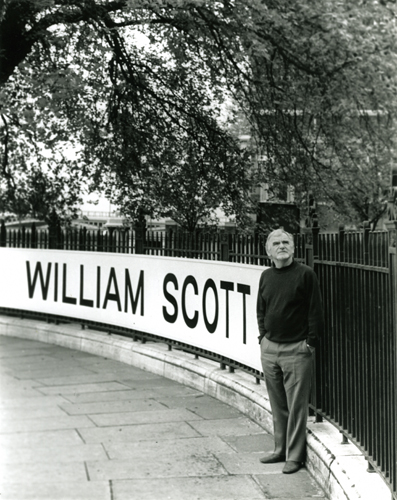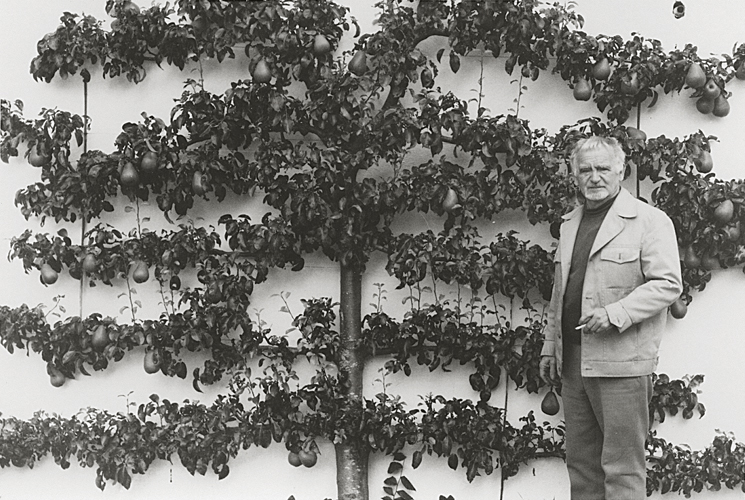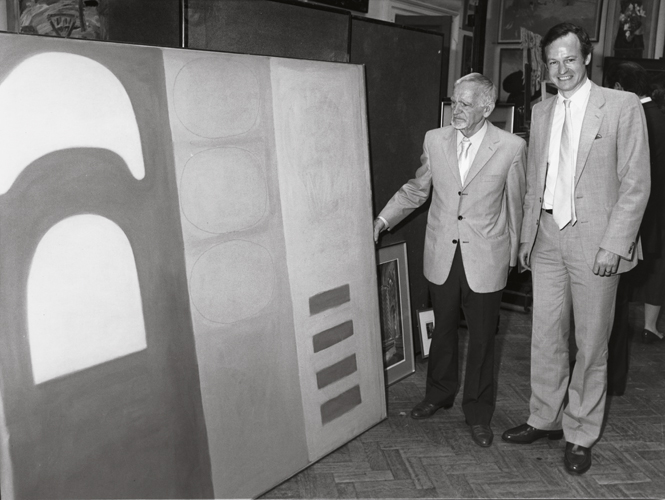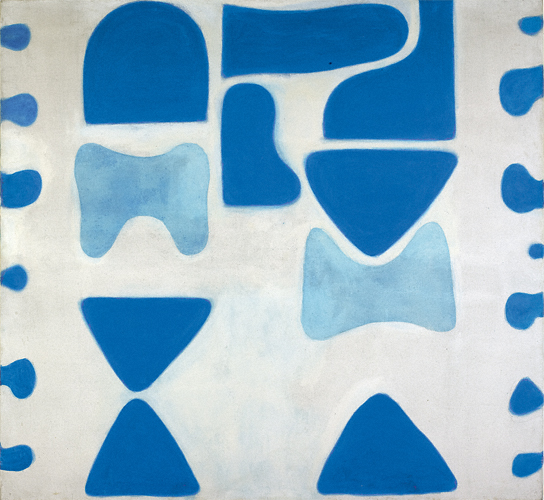
1970
February
On 25 February, Mark Rothko killed himself in his New York studio.
May
On 28 May, Scott attended the opening of the Rothko Room at the Tate in which nine paintings presented by Rothko to the gallery were put on display on Millbank (they now hang in Tate Modern). The works had arrived at the Tate Gallery on 25 February, the day of Rothko’s suicide. Under the heading ‘Rothko’s Gift’, The Times reported on the event noting the presence of Scott, ‘the first European artist to visit Rothko in New York in 1953, when he had seen only one work of his in reproduction, but had heard of his reputation among young American artists’. The article goes on to quote Scott saying that Rothko ‘had a very strong feeling for England’. Rothko’s paintings were originally intended for the Four Seasons Restaurant on the ground floor of the Seagram Building in New York, a commission the artist had mentioned to Scott when he visited him in 1959 at Elm Tree Cottage, Hallatrow.
Winter
Around the end of this year Mary Scott was taken ill. She was subsequently diagnosed with coeliac disease, an autoimmune disorder.
1971
March
A Girl Surveyed, a small book containing 11 ‘drawings in blue’ by Scott, accompanied by five poems by Edward Lucie-Smith, was published by the Hanover Gallery to accompany an exhibition of works on paper on the same theme. According to James Scott, his father had intended to include his own erotic poems but the Hanover Gallery had persuaded him otherwise.
Summer
Scott lent two works (unidentified) to the inaugural exhibition at Hillsborough Arts Centre in County Down, Northern Ireland.
Scott contributed a gouache to Variations on a theme of Titian, a campaign organised by the ballet critic and writer Richard Buckle to save Titian’s Death of Actaeon for the nation. Buckle had asked a number of artists to contribute works, which were to be sold at a fundraising gala: these were reproduced in Art & Artists, August–September, 1971.
1972
During the first few months of the year Scott made a second illustrated, recorded lecture for the British Council. The first lecture had been recorded in 1959, and in view of the major retrospective exhibition at the Tate Gallery opening in April, an updated version was required.
March
A documentary film on Scott, produced by Arts Council, was recorded for the BBC. A letter to Scott from BBC TV, dated 5 April 1972, reveals that part of the film had been shot in Scott’s Somerset studio on 29 and 30 March, ‘in connection with Review’, the name of the programme, which was timed to coincide with the Scott retrospective exhibition held at the Tate Gallery in April (see below). It was broadcast on 21 April.
April
William Scott, Paintings Drawings and Gouaches 1938–1971, opened at the Tate Gallery on 19 April (closed 29 May). This major retrospective exhibition was organised by Alan Bowness in collaboration with the artist. The catalogue was written by Bowness and was his second text to appear on the artist (the first was his monograph of 1964). The exhibition was designed by the artist’s son, Robert Scott. Critical reaction to the exhibition was generally favourable, particularly about the work of the 1950s.
On 27 April Scott was filmed in the exhibition by the BBC for an edition of the arts programme Omnibus. The programme was transmitted on 4 May.
November
The Scotts left England to spend two weeks travelling in Switzerland, Italy and France. During their stay they took in various commercial galleries in Milan interested in showing Scott’s paintings: Galleria Blu, Falchi Arte Moderna and Lorenzelli Arte. On their way back they visited Gustave Courbet’s house at Ornans (Doubs). They returned to London via Calais on 14 November.
1973
January
William Scott opened at the Martha Jackson Gallery on 3 January (closed 10 February). The Scotts had left for New York on 29 December 1972 to attend the opening, staying in the Hamptons before travelling to Buffalo, New York, and from there to Toronto.
February
Ulster Faces II: Kathleen Bridle William Scott T.P. Flanagan opened in Enniskillen on 12 February (closed 22 February).
March
The Hanover Gallery closed down on 31 March.
March–April
William and Mary left for India on 28 March, where they visited Delhi and Agra. On 2 April they left for Singapore, and from there they travelled to Perth, Australia. The visit to Australia was at the invitation of the British Council in New South Wales, which had arranged for Scott to give a lecture tour. At the suggestion of Lou Klepac, Scott was also one of the judges for the Perth Prize for Drawing International 1973. (The AUS$1,000 prize was awarded to Domenico de Clario for his drawing, Australia II.) After Perth, the couple travelled to Adelaide, Sydney and Melbourne.
May
The Scotts arrived in Mexico on 6 May, and stayed five days in Mexico City before moving on to Oaxacha. They flew back to London on 15 May.
1974
January–March
Between 10 January and 21 March Scott made six visits to the Printmaking Department of the Royal College of Art, London, as a Visiting Lecturer. In February, he was included in an exhibition of work at the Royal College of Art by staff (past and present) of the Printmaking Department.
March
William Scott Neue Bilder opened at Gimpel & Hanover Galerie, Zurich, on 9 March (closed 13 April). The catalogue lists 19 oils painted between 1971 and 1974, 16 of which were painted in 1973. The catalogue printed extracts from Hilton Kramer’s review in the New York Times of the exhibition at the Martha Jackson Gallery in January 1973.
August
Scott was invited by the painter Peter Blake to participate in The Last Festival, an exhibition at the Festival Gallery, Bath. The exhibition opened on 23 August (closed 14 September). In a letter dated 26 April 1974, asking Scott to send a painting, Blake told him that the list of contributors was as diverse and ‘classy’ as he could make it, the common denominator being that the artists lived or worked close to Bath. Among the other exhibitors were Howard Hodgkin, John Hoyland, Richard Smith, Joe Tilson and John Eaves.
September
William Scott Recent Paintings opened at Gimpel Fils, London, on 3 September (closed 28 September). The exhibition had been shown earlier in the year at Gimpel & Hanover Galerie, Zurich.
Scott was included in British Painting ‘74, which opened at the Hayward Gallery on 26 September (closed 17 November). The Arts Council had invited Andrew Forge, a painter as well as an art critic, to organise the exhibition which was the second in a projected series of biennial surveys. The first, The New Art, selected by Anne Seymour, had taken place in 1972. Her choice had concentrated on sixteen new generation avant-garde artists and Forge’s exhibition was a spirited rejoinder to what had proved to be a personal and highly controversial selection. His first step was to absent himself from the selection process by asking 25 painters, including Scott, to nominate up to ten artists for inclusion in the Biennial.

1975
This year is unusual in that Scott appears to have painted only one work in oils and even the date of this work is uncertain as it was signed and dated many years later. The artist’s energy seems to have gone into producing works on paper of which over 120 in various media are recorded. Among these was an offset lithograph, Blue Still Life, commissioned by the Department of the Environment and printed by the Curwen Studio. It was the only unlimited print made by Scott.
January
William Scott “Drawings Surveyed” opened at the Martha Jackson Gallery, New York, on 4 January (closed 1 February). The exhibition was presented on three floors and included over 50 drawings spanning the years from 1956. The Scotts attended the private view.
William Scott Gouachen opened at Galerie Angst + Orny, Munich, on 8 January (closed 19 January). According to the owner of the gallery, Helga Orny, the exhibition was not a success, a fact she attributed to Munich’s conservative climate. A handwritten list of works found amongst the artist’s papers is headed ‘Gallery Orny’ and suggests that Scott may have shown five oils as well as gouaches and drawings.
February
Bryan Wynter died on 2 February, and Roger Hilton on 23 February.
April
William Scott: Exhibition of Drawings opened at the Gallery Moos, Toronto, on 5 April (closed 24 April). The exhibition was essentially the one that had been shown at the Martha Jackson Gallery in January of the same year.
4 July
Scott received an Honorary Doctorate from the Royal College of Art.
September
The Scotts visited Ireland.
1976
January
William Scott, opened at the Gallery Kasahara, Osaka, on 16 January (closed 7 February). The exhibition consisted of six oils, sixteen gouaches and two prints.
Ryunosuke Kasahara, a young art dealer, was an enthusiastic promoter of contemporary western art. The catalogue introduction, ‘Between Realism and Abstraction’, was written by Chuji Ikegami, Associate Professor in the Faculty of Letters at Kobe University. Kasahara had come across Scott’s work through a visit to Gimpel Fils, and had arranged an introduction to the artist through Kenneth Armitage, whose work Kasahara had recently shown.
May
The Scotts travelled to Tokyo for the opening of a second exhibition organised by the Gallery Kasahara on 17 May (closed 29 May). The exhibition, which was held in rented premises as Kasahara did not have a gallery in Tokyo, was a larger version of the show held in Osaka in January, and included 11 oils from 1950 to 1976 and 25 gouaches mostly painted in 1975 and 1976.
William Scott: New Gouaches and Collages opened at Gimpel Fils, London, on 25 May (closed 26 June). The exhibition included 25 gouaches painted between 1975 and 1976, and Excursions 1–9, a group of works described in the catalogue as a ‘series of nine experiments in mixed media’.
July
Scott was awarded an Honorary D.Lit. from Queen’s University, Belfast. On the same visit to Northern Ireland he presided over the graduation ceremony at Belfast School of Art. In his speech to the students Scott affirmed his long-held belief that the art school played a vital role in education. ‘There are three main branches of art,’ he told his audience, ‘educational, industrial and fine art. The purpose I feel of an art school is to provide these branches with ideas and inspiration. The art school in fact should be the community’s laboratory centre of visual experiment, the place where new ideas will be generated. In fact, the spirit that made the Bauhaus so successful is still more than ever necessary today.’
August
The Scotts spent a week in Gozo, Malta, where their son Robert had a house. The rest of the summer and autumn were spent mostly in the country, at their house at Coleford.
September
Green Predominating, Scott’s lithograph drawn on a zinc plate, was published in an edition of 40 by Editions Alecto, London.
1977
January
Following the sale of the Martha Jackson Gallery in December 1976, David Anderson moved the gallery to another location in New York City (521 West 57th Street).
May
Scott was elected an Associate of the Royal Academy.
June
The exhibition Real Life, organised by Edward Lucie-Smith as a Peter Moores Liverpool Project, opened at the Walker Art Gallery in Liverpool on 2 June (closed 6 September). Scott showed his series of 17 small paintings titled An Orchard of Pears. Lucie-Smith, who was a poet as well as a critic, published a poem in the catalogue, which is printed as a full page following the list of Scott’s paintings. Titled Five Morsels in the Form of Pears, it is dedicated to Scott and Erik Satie (a reference to the composer’s composition for piano duet Trois morceaux en forme de poire).
July
Scott received a doctorate in letters (Litt.D) from Trinity College, Dublin.
William Scott: Twelve Recent Paintings opened at the Dawson Gallery, Dublin, on 9 July (closed 23 July). The 12 works were still-life compositions painted between 1976 and 1977. Leo Smith, who had founded the Dawson Gallery, died the week before the exhibition opened. The following year John Taylor, who had worked in the gallery since 1968, continued to run the gallery before setting up the Taylor Galleries in Dublin.
In the second week of July the Scotts went to Brittany. During their stay they visited the Hôtel de la Poste in Pont-Aven, which they found little changed from their time there in 1938–9.
September
British Painting 1952–1977 opened at the Royal Academy of Arts, London, on 24 September (closed 20 November). In this survey of British art Scott was represented by three paintings.
1978
March–April
Scott made a short trip to New York to see David Anderson and his new gallery space. While there, he attended the opening of the Antoni Tapiès exhibition at David Anderson’s gallery on 31 March.
May
William Scott “Permutations” opened at Gimpel Fils on 23 May (closed 24 June). The series Permutations was made up of seven large canvases numbered 1 to 7, with the dominant colour of each painting included in the title, e.g. Permutation 1 – Blue. The series included an eighth canvas, which was finished towards the end of April, but which was not shown in the Gimpel Fils exhibition.
1979
January
Scott completed two lithographs commissioned by Christie’s Contemporary Art, Grapes and Pears, each printed by Curwen Studio and published in an edition of 150.
May
William Scott Still Life Paintings 1946–1978 opened at Fermanagh County Museum, Enniskillen, on 19 May (closed 14 July). The exhibition of 25 paintings toured to the Orchard Gallery, Londonderry, and the Arts Council Gallery, Belfast. T.P. Flanagan wrote a short introduction for the catalogue.

1980
March
Following David Anderson’s decision to close his gallery, Scott was forced to make new business arrangements, and was subsequently represented in New York by Gimpel & Weitzenhoffer.
May
Poem for a Jug, an exhibition of 26 oils on a single theme painted between 1979 and 1980, opened at Gimpel Fils, London, on 20 May (closed 21 June). The title was a play on Keats’s Ode to a Grecian Urn.
On 29 May the Scotts left for Greece where they spent three weeks on the island of Corfu staying in a small house lent to them by the Munich gallery owner Helga Orny and her husband Ludwig.
1981
February
William Scott War Paintings 1942–46 opened at the Imperial War Museum, London, on 11 February (closed 1 March). The exhibition, organised by Angela Weight, was the first in which Scott consented to show a selection of the large number of watercolours and drawings he had made during the Second World War.
November
Scott underwent a successful operation for a cataract in his left eye.
1982
September
Mary Scott suffered a severe stroke that left her paralysed down one side. She spent 12 weeks in hospital.
1983
April
William Scott opened at Gimpel & Weitzenhoffer, 1040 Madison Avenue, New York, on 26 April (closed 28 May). The artist travelled to New York for the opening.
May
Mary Scott fell and broke a leg while learning to walk again. Shortly afterwards, she suffered a second stroke.
1984
March
A letter dated 22 March from Peter Gimpel to Scott indicates the general slowing down of the artist’s output: ‘I quite understand that, of course, you cannot have a show if you have not painted recently. We will rely on you to let us know at least six months ahead when you are ready.’
June
Scott was elected a Royal Academician. His Diploma work, Still Life with Pears, a painting of c.1956, was accepted by the Royal Academy on 23 April 1985.
December
Scott’s early life was the subject of Every Picture Tells a Story, a feature film directed by James Scott and produced by Christine Oestreicher for Flamingo Pictures with TSI Films for Channel 4. The 85-minute film was first shown at the National Film Theatre on 1 December as part of the 28th London Film Festival. Scott was in the audience. The screenplay was by Shane Connaughton and the cinematography by Adam Barker-Mill.
1985
March
Clifford Ellis, the former Principal of the Bath Academy of Art, died on 19 March.
May
Scott was awarded the Korn/Ferry Prize at the Royal Academy’s Summer Exhibition. Following tradition, prizes were presented on Varnishing Day, which this year was on 22 May. The new £5,000 prize awarded ‘for a work of exceptional merit’ was given by the executive search consultants Korn/Ferry for ‘Variations’. The judges were Edward Clark (Korn/Ferry), Dr John Golding, John Hoyland ARA, William Packer and Professor Eduardo Paolozzi CBE, RA.
1986
May
For the second year running Scott was awarded the Korn/Ferry Prize at the Royal Academy’s Summer Exhibition. This time the prize was split between Scott for his painting Figure and John Hoyland’s Don’t Explain 14.2.83. The judges were Edward Clark (Korn/Ferry), Geoffrey Clarke RA, Richard Cork, Allen Jones ARA and Leonard Manasseh.
June
An important retrospective opened at the Ulster Museum, Belfast, on 13 June (closed 3 August). The exhibition, organised by the Arts Councils of Ireland, travelled to the Guinness Hop Store, Dublin and the Scottish National Gallery of Art, Edinburgh. It was one of a series presented annually by the Arts Councils in Ireland to draw public attention to the achievements of distinguished Irish artists. The catalogue included essays by Ronald Alley, the recently retired Keeper of the Modern Collections at the Tate Gallery, and T.P. Flanagan, the painter and critic who was also a long-standing friend of the artist. The artist visited the exhibition when it was shown at the Guinness Hop Store.
August
By now Scott had virtually stopped painting. In early August he was diagnosed with Alzheimer’s disease, the symptoms of which had become gradually apparent over the previous few years.
1987
Scott was left out of British Art in the 20th Century: The Modern Movement, a major survey organised by Norman Rosenthal at the Royal Academy of Arts.
May
William Scott: Paintings 1953–1986 opened at Gimpel Fils, London, on 19 May (closed 20 June). This was a small exhibition of nine oils ranging in date from 1953 to 1986.
1988
Scott completed his last lithograph, Still Life with Lemons, with Stanley Jones of the Curwen Press. It was published by the Scott Estate. According to Stanley Jones, it was based on a tracing made from an original gouache. Some of the marks were made by Scott on the tracing sheet, but the lithographic process (on a zinc plate) was completed by Jones.
September
William Scott opened at the Berkeley Square Gallery, London, on 26 September (closed 15 October). The exhibition, organised by the sculptor David MacIlwaine and consisting of 31 works, was described on the catalogue cover as ‘A Major Retrospective’.
1989
December
Scott died at his home in Coleford on 28 December. The death certificate, dated 2 January 1990, gave the causes of death as ‘Intra cerebral haemorrhage Ib: Cerebral altherssclerosis: II: Senile Dementia’.
1990
January
A funeral service was held at Holy Trinity Church, Coleford, on 3 January. Scott, however, had asked to be buried in the grave that contained his father as well as his baby sister Violet in Breandrum Cemetery, Enniskillen. The burial took place in Northern Ireland on 15 January. The painter T.P. Flanagan gave the address at the Service of Thanksgiving held in the Chapel of Rest.
March
A memorial service for the artist was held in London at St James’s, Piccadilly, on 20 March. According to Mary Scott about 400 people attended; with Mervyn Levy reading a Dylan Thomas poem and Patrick Heron telling evocative stories of Scott. A memorial exhibition was simultaneously held at the Royal Academy of Arts.
1999
April
On 28 April, Mary Scott died at home in Coleford and was buried with her husband in Breandrum Cemetery, Enniskillen.

